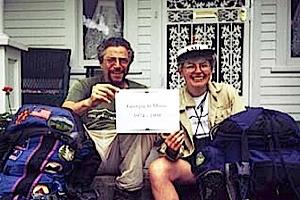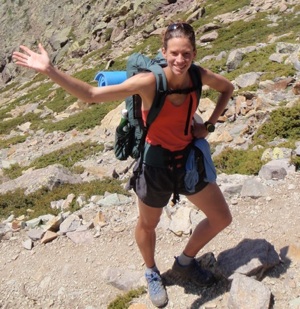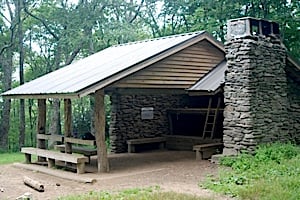Is 2012 your year to hike the Appalachian National Scenic Trail? It's not about the gear; it's about wanting to do it.
If you’re trying to figure out if you have the right stuff to walk 2,181 miles from Georgia to Maine, listen to Andrew Downs who finished the A.T. in 2002, a year after graduating from college. He now works as the trails resources manager for the Appalachian Trail Conservancy in the Southern Region.
"I was 22 when I hiked the trail so I could handle the physical challenge," Andrew says. "But the key to success for young people is to keep the distractions down. The more you stay on the trail, the better. If you go into town too much, you're spending money, maybe on alcohol, and you're not hiking."
Leanna Joyner, who thru-hiked the A.T. in 2003 agrees.
“Success has to do with enjoying your surroundings and having a positive attitude despite uncomfortable circumstances such as rain and cold," she says. “Yes, the right gear always helps. But having an openness to learn, to be challenged and to be adaptable are very important.”
Most people who thru-hike the A.T. do it at a point of transition in their lives: graduation, retirement, losing a job or a life partner. When you complete the trail, you will be forever known as a 2000-miler – you can put that on your transcript and your tombstone.
A Little History
Several names will always be associated with the A.T. Benton MacKaye was the thinker and advocate for wilderness. In 1921, he proposed a footpath through the wilderness connecting mountains from New England to the Southern Appalachians. He's considered the father of the A.T.
Myron Avery turned MacKaye's musings into a reality. He was the doer who organized hiking clubs, developed volunteers to build the actual trail, and headed the Appalachian Trail Conservancy for many years, all while working as a maritime lawyer. ATC, a private non-profit organization, is the umbrella for the 31 volunteer clubs who built and now maintain the trail. Avery became the first 2,000-miler by walking the whole A.T. in sections in 1936.
Earl Shaffer was the first thru-hiker, walking the whole A.T. in four months in 1948. In 1955, Emma “Grandma” Gatewood was the first woman to complete a solo thru-hike. After raising 11 children (now, there’s a life transition) in southwest Ohio, she first hiked the A.T. at age 67 and went on to hike the A.T. two more times, becoming the first person to walk the trail three times, the last time at age 76.
This was before the days of lightweight backpacks and sleeping bags. She wore tennis shoes and carried her gear, an army blanket, a raincoat, and a shower curtain, in a duffle bag swung over her shoulder. One of her famous lines was, “Most people are pantywaists. Exercise is good for you.”
The Reality
Flowers, mountaintops, dramatic sunsets, and bear sightings are the rewards, but they don’t happen every day. An A.T. hiker needs to be a linear thinker; go north, follow the white blazes, make your miles, stop for the night before you drop.
Laurie Potteiger, information services manager at ATC and a thru-hiker herself, has a lot of interaction with A.T. hikers. She understands that, "You have to have a burning desire to complete the trail. Hiking while it's fun is not going to get you there."
Thru-hikers are trying to walk the trail in one continuous march between mid-March and the beginning of October. If they start earlier, they can be walking in snow or caught in a blizzard in the southern Appalachian Mountains. Georgia may be the South, but it's still in the mountains. If hikers reach Baxter State Park in Maine later in the fall, they'll find the park closed.

Danny and Lenny with their "Georgia to Maine" in 25 years sign.
Lenny and I were section hikers who walked the trail over many years on our vacations, completing the trail in 1998. On each section, we started at one point, walked for a couple of weeks and needed to reach our car by a certain date to drive home and get back to work.
In many ways, section hiking is harder because you have to be in shape before you start a new section each year. You need a regular work life where you're guaranteed at least a couple of weeks of vacation a year. We saved every vacation day for the A.T.
ATC doesn't distinguish between those who thru-hike in one year and those who section-hike the trail, calling us all 2000-milers. In 2010, 631 people completed the trail, 104 of them section-hikers. Neither thru nor section hikers can follow their own muses; they need to follow the white markers.
Jennifer Pharr Davis, who set a world record by finishing the A.T. in less than 47 days earlier this year, explains that "the skills required by the Appalachian Trail, including goal-setting, planning, positive thinking, and flexibility are applicable on the trail and in everyday life."
She claims her success to organization and consistency, not speed.

Jennifer Pharr Davis. Courtesy of Jen.
How long will it take you? It depends on how much you walk per day and how many zero (non-hiking) days you take. If you average 13 miles a day six days a week, it will take you six and a half months. Most backpackers walk more since the hiking day is so long – you don’t have to drive to the trailhead.
On the seventh day, you don’t rest; you do laundry, take a shower, buy and repackage your food, send postcards home.
"Postcards?", I can hear you saying. One piece of advice. If you call home too often and get pulled back to your family life, you’ll find yourself leaving the trail to go to your cousin’s wedding and worrying about your sister’s divorce. If nobody died and nobody went to jail, keep on walking.
For this adventure, other A.T. hikers are your family. Starting out in mid-March at Springer Mountain, Georgia, and walking north is the traditional way to do it. You'll walk through a garden of wildflowers in the spring and gorgeous leaf color in the fall. You'll make friends and find it easier to hitch into town. Some call it a moving party.
If you can't start until June and you walk south from Mt. Katahdin, you'll get the hardest sections done first. You'll have more peace and quiet and feel less time pressure. Fall colors will stretch out for miles before you and you may still catch fall wildflowers in the south. Meeting other hikers is part of the fun. If you start out by yourself – and most successful hikers do it solo – you’ll meet people at shelters and be able to pick and choose your companions at different points.

The Spence Field Shelter in Great Smoky Mountains National Park. Kurt Repanshek photo.
Shelters, planned about a day’s walk apart, are three sided-structures with a tin roof and the fourth side open to the elements. Hikers keep in touch through the shelter log book.
Notebooks were put in shelters for safety so that hikers could enter their intended route. It’s also used for musings, exaltations, and complaints about the trail, nature, and food. Entries are sometimes accompanied by elaborate drawings.
Walked 15 miles today, saw a snake heading into the grass. Looking forward to some chow. Curry noodles tonight.
The Superlatives, In My Opinion
The easiest – Shenandoah National Park. The Skyline Drive crisscrosses the A.T. and provides many places to eat, take a break and throw out your trash.
The hardest – The New Hampshire/Maine border – Mahoosuc Notch is known as the toughest mile on the A.T. When negotiating the rocks in the White Mountains, I threw my pack down ahead of me, scrambled down, picked up the pack, and repeated the process.
The most boring – Massachusetts is the ultimate green tunnel. I felt like I was walking around in a circle and would never get out.
The most exciting and varied – I'm living in it. The Southern Appalachians has the highest point (Clingmans Dome), outstanding views, balds, hospitable trail towns (Hot Springs and Franklin, North Carolina and Damascus, Virginia), and wonderful spring flowers.
Your First Steps
The A.T. might be the most documented trail in the world with its books, movies, blogs, listserv, and myths. Look at Kurt's article on long-distance trails. Join the Appalachian Trail Conservancy. Buy the Appalachian Trail Data Book (updated yearly) and the A.T. Thru-Hikers’ Companion.
And listen to Grandma Gatewood who said, “It takes more heart than heel.”
Good luck and have fun!


 Support Essential Coverage of Essential Places
Support Essential Coverage of Essential Places







Comments
You're right about section hiking being harder than thru-hiking, but it has its rewards. Thru-hikers have to focus on the A.T. and only the A.T. Section hikers have the luxury of learning more about the towns an attractions around the Trail. Also, many thru-hikers hike the A.T., then move on to other things. Section hikers commit to the A.T. for many years, and usually keep that commitment after they have completed their 2,000 miles.
Lenny Bernstein
What was Andrew's trail name?
Steamboat GAME 2002
No mention of Mark Sanford?
I want to have Grandma Gatewoods pantywaist quote in my living room - I love it. Danny, you have to give MA another try. When it is not bug season, it is quite lovely. Great article - if people prepared there hearts and minds as much as their gear there would be far more finishers.
Hi YPW:
Thanks for reminding me of Mark Sandford - he's history now, maybe a footnote in a Trivial Pursuit game. For those who missed this comedy, Mark Sandford is the former Governor of South Carolina. A few years ago, while in office, he said he was going to hike a few days of the A.T. All the while, he visited his mistress in South America. Reporters quite enjoyed that.
Danny Bernstein
www.hikertohiker.com
Alas, Danny, we South Carolinians can only wish that Mark Sanford would disappear. Fox News has hired him as a political commentator through the 2012 election.
Hi! My trailname is Digger, I started in April and finished (after a few distractions) in October.
His name was Digger. He commented at the bottom.
Danny